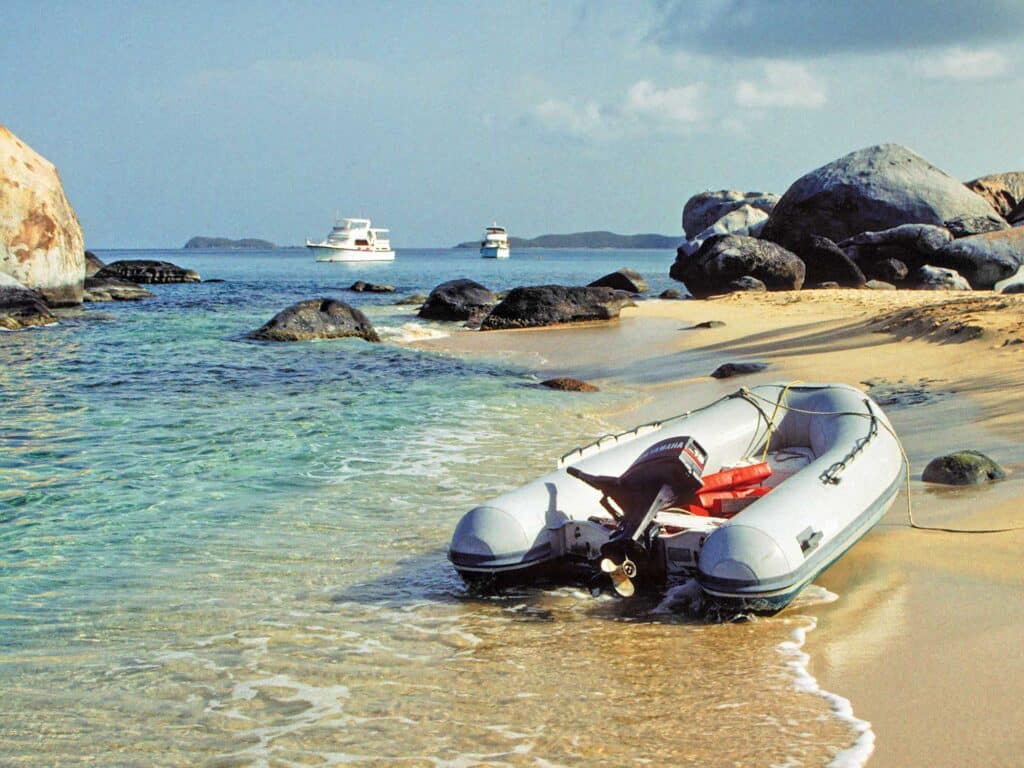
There is an old saying in the Abacos: “Some people, most mules and all dinghies are nothin’ but trouble.” I learned to believe in this saying during one of my early charters in the British Virgin Islands. We were towing a hard-bottom dinghy from Tortola to Norman Island. Everything was fine until someone asked, “Hey, where’s the dinghy?”
The tender had been at the end of a long painter made of yellow braided polypropylene, which the charter company used because it supposedly floats, making it harder for bareboaters to wrap it around their props. The fact is that this material is also one of nature’s slipperiest substances. As we slapped and splashed along, it was slipping off the cleat until it was gone.
Luckily, we were able to sail back and find the tender before it became an embarrassingly expensive addition to our charter bill. But here’s the thing I particularly remember: Once we had the retrieved tender in tow, it tried to get away again. We put that yellow poly line on the stern cleat, but, as I watched it, it would slip out an inch at a time. I ended up throwing a bowline in the extra line around a stanchion, just to make sure it didn’t get away.
The most dangerous moments on your bareboat charter are not going to be tiptoeing through a shallow harbor entrance or dealing with a passing squall. They’re going to be with your tender: getting in or out, beaching it, hoisting it out of the water.
Here’s a look at some hard-won wisdom about dealing with tenders.
At Your Charter Checkout
If you have a choice, always ask for a RIB. This type of boat combines the best of inflatables and hard-bottom tenders: a solid bottom for beaching and a soft side to protect your hull.
Always—always—start the outboard before leaving the charter base, and make sure the motor is spitting out water. Ask the checkout person if there are any idiosyncrasies with the engine: Employees know this stuff and can save you grief later. Ask about the proper fuel mix too. Some outboards need an oil/fuel mixture. And make sure the fuel tank is full.
Other gear you should have in your tender includes a painter long enough for towing, an anchor (probably a folding grapnel style), oars or paddles, a bailer, a safety kill switch for the outboard that you hook to your wrist or jacket, and a dive flag to alert other boats that you are snorkeling.
Launching the Tender
Modern charter boats often have sophisticated systems that let you launch and retrieve a tender with the touch of a button. Still, always hang on to the painter when launching, or have it secured to the boat. Once you remove the hoisting clips, the tender can skitter away very quickly. And, once you’ve removed the lines from the hoisting system, clip them someplace secure. Otherwise (and I guarantee this), they’ll bang you hard on the forehead when you aren’t watching.
Boarding the Tender
The first order of business is to secure the tender solidly, which means using bow and stern lines to keep it at the mothership’s stern. Trying to step into a tender, even from a water-level platform, is asking for trouble. Leave your ego for somewhere else: squat, scoot, kneel, crawl or find a way to slither aboard safely. Graceful? No. Dry and safe? Yes.
Using the Tender
Too many people get aboard, cast off, and start the outboard—in that order. They are the ones often paddling upwind to get back to the boat when the outboard doesn’t start. Start the outboard first, then cast off.
One absolute rule for using your tender: Don’t drink and dink. Tenders are squirrelly enough without you adding to the silliness.
Before you leave your bareboat, always make sure the engine clamps are tight, because an afternoon of being towed can cause them to loosen. Make sure you have the oars or paddles aboard, check the fuel level, and, if you’re going to a beach, have the outboard ready to tilt up. Some outboards have complicated (and finger-pinching) tilt locks that you don’t want to leave until the last moment.
Tender Sense
Before you leave your bareboat, even if you think it’s only for a quick trip, turn on some lights. This will make finding your mothership easier on a dark night. I know one crew who ended up sleeping on the beach because they couldn’t find their boat. I always take a handheld VHF radio on my bareboat charters, just for use in the tender. If the outboard dies, you can call for help. And, if you’re letting the kids take the tender, they can check in with you on a regular basis.
Nonswimmers, or anyone nervous, should always wear a life jacket. Even if you’re not wearing them, they still have to be aboard. You don’t want to receive an expensive citation for failing to have PFDs.
Never start the outboard unless you have the safety kill switch firmly around your wrist or snapped to your jacket. Don’t even think about what a turning prop can do to someone in the water. Wear the lanyard.
Beaching
Getting your tender onto a beach safely is a test of your seamanship. If there are breakers, find another way. You may be Surfer Joe, but a tender is a lot more unwieldy than any surfboard. Find a quiet cove, or anchor offshore and swim ashore.
Forget about staying dry. I can count on one hand the number of times I’ve arrived on shore bone-dry. There are two popular ways to get the tender ashore. One is to make a run at the shore and, as you get close, tilt the outboard up to protect the prop. With the bow high (passengers leaning aft), you’ll slide onto the beach, and someone at the bow can jump out to hold the boat. The other way is to get close, shut off the engine, step into knee-deep water, and slide the tender onto the beach.
Either way, don’t let anyone get between tender and beach. A sudden swell can send the tender into their legs, knocking them down and even breaking bones. Until you get the tender solidly on dry sand, treat it like a wild animal that might turn on you.
And once you’re at the beach? Tie your tender to something solid. If there isn’t a big rock or a tree nearby, use your anchor and set it solidly. There is this thing called “tide.” When it comes in, it loves to take tenders away.
Towing
Aside from the warning about slippery yellow lines, towing should be straightforward. First, remove all the gear (snorkels, masks, etc.) from the tender. Then, let out the tender to a point where it is riding comfortably behind the mothership.
When you are starting to maneuver, such as dropping anchor or picking up a mooring buoy, assign one person to do nothing but be the Tender Tender. Take in the painter so that you won’t suck it into the props. The Tender Tender can move it from side to side if you’re docking.
Putting the Tender to Bed
Tenders can be like friendly pets in the middle of the night: They like to nuzzle their master, usually on the hull right next to where you’re sleeping.
One solution is to tie a bucket off the stern of the tender, to encourage it to keep its distance. Another option, if there is room, is to tie the tender to your mooring buoy and then drop back for separation.
Tenders: We can’t live with ’em, can’t live without ’em. Common sense and some precautions make them a lot easier to have around.
Award-winning journalist Chris Caswell is editor and publisher of chartersavvy.com. He has been bareboat chartering for more than five decades.








